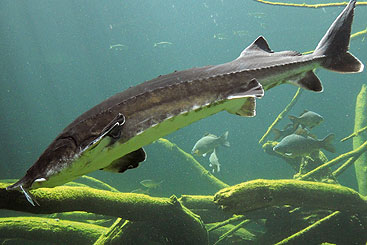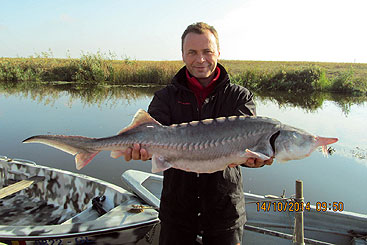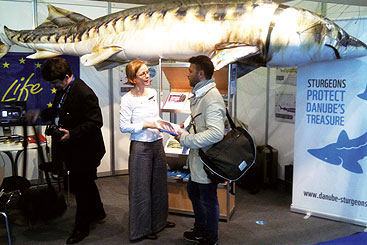The fight to save Danube sturgeons

The fight to save Danube sturgeons
Although Danube sturgeons represent a natural value and a cultural heritage of the Danube region, threats such as habitat destruction, blocked migration routes and especially overfishing have brought them to the brink of extinction. Urgent conservation measures are needed before it’s too late.

Because of the complex demands on their habitats, sturgeons are considered a `flagship species’. By preserving the habitats and dynamics that satisfy the needs of this species, it is possible to protect the living spaces of many more species. © WWF/Jutta Jahrl
Present at the time of the dinosaurs, sturgeons have changed very little over their 200 million years on Earth. Until the 20th century, six sturgeon species inhabited the region, supporting the livelihoods of many communities along the Danube and some migrating from the Black Sea up as far as Germany to reach their spawning grounds. Today, five sturgeon species are critically endangered – with one of these already extinct in the Danube – and one is considered vulnerable. Without the concerted action of dedicated individuals across the Danube Basin and support of the Danube countries, these ancient species might just disappear.
“Along the Danube River, there are a lot of stakeholders,” says Cristina Sandu, Coordinator of the Danube Sturgeon Task Force at the Institute of Biology Bucharest, Romanian Academy. “Drinking water, industry, agriculture, hydropower, navigation, flood protection, tourism, etc. – all these add new pressures on the aquatic environment, and hence, a wise prioritisation between water uses and nature conservation is needed.” For Danube sturgeons, this prioritisation comes in the form of the EU Strategy for the Danube Region, which seeks to integrate existing EU policies across the Danube Basin. One of the targets of Priority Area 6 of the Danube Strategy is to “secure viable populations of Danube sturgeon species and other indigenous fish species by 2020”.
“The Danube Strategy is really excellent because it provides a dialogue platform to bring all the people together and discuss the same issues,” says Sandu. “It’s important to work together to identify balanced solutions that allow both economic development and biodiversity conservation along the Danube River.”
The Danube Sturgeon Task Force. To meet the goals of the Danube Strategy, sturgeon experts, NGOs and representatives of national governments and the ICPDR established the Danube Sturgeon Task Force (DSTF) in 2012. The DSTF coordinates the conservation of native sturgeon species in the Danube River Basin and the Black Sea by implementing the Sturgeon 2020 programme, which combines environmental protection with the social and economic development of local communities.
The DSTF aims to mobilise support for sturgeon conservation across the entire catchment area. While efforts in the Middle and Lower Danube focus on preserving the remaining wild individuals and their key habitats and restoring river connectivity at the Iron Gates and Gabcikovo dams, iin the Upper Danube the focus is on habitat restoration and building functional fish passes to allow migrants to reach their historical habitats. Among other activities, the DSTF’s recent work has focused on preparing several pilot projects to conserve natural habitats and facilities outside natural habitats, establish eco-tourism activities and communicate the needs of sturgeons to the greater public.
As part of public awareness-raising activities, the DSTF organised a public event to celebrate World Fish Migration Day, together with the National Museum for Natural History ‘Grigore Antipa’ in Bucharest, WWF Romania, the International Association for Danube Research and the Institute of Biology, Bucharest, Romanian Academy. Hosted by Grigore Antipa Museum, World Fish Migration Day aimed to raise awareness of the worldwide decline of migratory fish species as a result of overfishing, habitat loss and the need to restore river connectivity to allow migratory movements between various habitats as part of the natural life-cycle. The event included a sturgeon exhibition in the museum and an aquarium with living sturgeons; two presentations on sturgeon life, threats and measures to conserve the species and contests and activities for children.

Despite surviving on
Earth for millions of years
sturgeons face numerous
threats to their survival -
such as habitat destruction,
overfishing and blocked
migration routes. According
to the International
Union for Conservation of
Nature, sturgeons are more
critically endangered than
any other species.
© SRG / DDNI Tulcea
Sturgeons at the Iron Gates dams. The first Danube River Basin Management Plan, published in 2009, called for a feasibility study on the possibility of sturgeon and other important species migrating upstream and downstream through the Iron Gates dams. Funded jointly by the Dutch ‘Partners for Water’ programme, the ICPDR and the participating institutions, a project to monitor the behaviour of sturgeons at the Iron Gate II dam ran from November 2013 to May 2014, led by Radu Suciu and sturgeon experts from the Sturgeon Research Group (SRG)/Danube Delta National Institute (DDNI) Tulcea. The results of the monitoring project will be crucial for the development of functional fish migration aids at the Iron Gate II dam.
To monitor the area, acoustic receivers were installed at the Iron Gate II hydropower plant and the hydropower plant on the Gogoşu secondary branch of the Danube. Although significantly low water levels during the spring migration meant few adult sturgeons entered the Danube from the Black Sea, sturgeons were captured and tagged with a tracking device. The results of the monitoring demonstrated that adult sturgeons born before and after the dam was built in 1984 still migrate to the Iron Gate II dam.
Furthermore, the project showed that the strong water current from the dam’s turbines significantly affects sturgeon behaviour. The monitoring of an adult male beluga sturgeon which spent nearly a week at the dam found it to swim repeatedly to the water’s surface – highly unusual for sturgeons. This was attributed to the very strong water current produced by the turbines (475 m3/sec/turbine) with an output depth of 9 metres, so that the highest water flow is found in the lower part of the river, forcing the sturgeons to use the top 2–3 metres of the water to maintain their position in the river.
Overall, the project provided the basis for proposing location and construction style of fish pass entrances. Another outcome of the project was a workshop organised by the Fisheries Department of FAO Rome and held in Tulcea, Romania in May 2014. The workshop was dedicated to tagging and tracking sturgeons in the Lower Danube River and drew participants from Romania, Bulgaria and Serbia. Discussions at the workshop revealed the true complexity of the monitoring study and experts at the workshop – from Austria, Norway and the Netherlands – rated the study one of the most difficult ever attempted in a large river system. One of the recommendations of the workshop rwas to conduct a one-year preparatory project to test, combine and adapt existing radio and acoustic telemetry equipment to achieve the resolution required to locate ideal sites for the entrance to future fish passes. Fortunately for sturgeons, the European Investment Bank in Luxemburg is considering funding such a project.

Actions to raise public awareness for sturgeons are vital to securing sustainable fish stocks. © WWF/Adriana Trocea
Putting a stop to sturgeon poaching. A Life+ project ‘Joint actions to raise awareness on overexploitation of Danube sturgeons in Romania and Bulgaria’ is targeting fishing communities, law enforcement agencies, decision makers, sturgeon breeders and caviar processors and traders in Bulgaria and Romania to stop the overexploitation of Danube sturgeons. Implemented by WWF in Austria, Bulgaria and Romania, the project is aligned with the Action Plan for the Conservation of the Sturgeons in the Danube River Basin, adopted by the Council of Europe in 2005. The project began in 2012 and will wrap up next year, with the goal to significantly reduce the illegal fishing of sturgeons in Bulgaria and Romania.
Two workshops were held this spring in Romania and Bulgaria for law enforcement agencies involved in controlling sturgeon fishing, sturgeon aquaculture and caviar processing and trade. The two-day workshops and practical training courses included information on sturgeons, fisheries control, aquaculture production, illegal caviar trade, national and international regularegulations and methods of fraud, smuggling and concealment. To support the control work of enforcement officials, the project team produced comprehensive manuals with detailed information on sturgeon biology and species identification, caviar trade, regulations and simple checklists for controlling caviar shipments.
Speaking up for sturgeons. To provide a voice for these endangered species in local communities, the project has established sturgeon advocates in Romania and Bulgaria to serve as information sources regarding sturgeon issues in the region. “At the beginning, our Sturgeon Advocates in Romania and Bulgaria made good contacts in some fishing villages, while in others it was rather difficult as fishermen were suspicious and very hesitant to talk about delicate issues like poaching and illegal caviar trade,” says Jutta Jahrl of WWF.
“After two years of project work, there are trustworthy relationships in many communities, and we have got a lot of interesting information and are able to understand the situation of fishermen much better,” says Jahrl.
To make a real difference to fighting the overfishing of sturgeons, the public and industry have to be informed. Project representatives brought a Danube sturgeon information stand – crowned by a 4.5 metre inflatable sturgeon – to the Global Seafood Expo in Brussels. The expo is the world’s largest seafood fare with more than 25,000 visitors. The stand provided information about the threats to sturgeons and the importance of sustainable and legal caviar trade, especially on the CITES labelling to distinguish legal from illegal caviar.
For more information, please visit www.danube-sturgeons.org, www.ddni.ro or www.dstf.eu.





